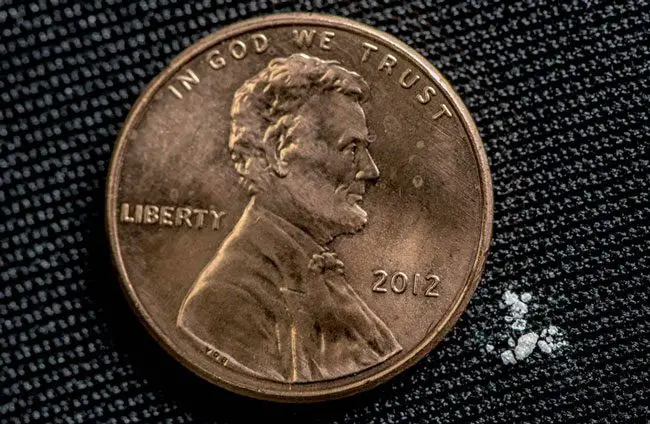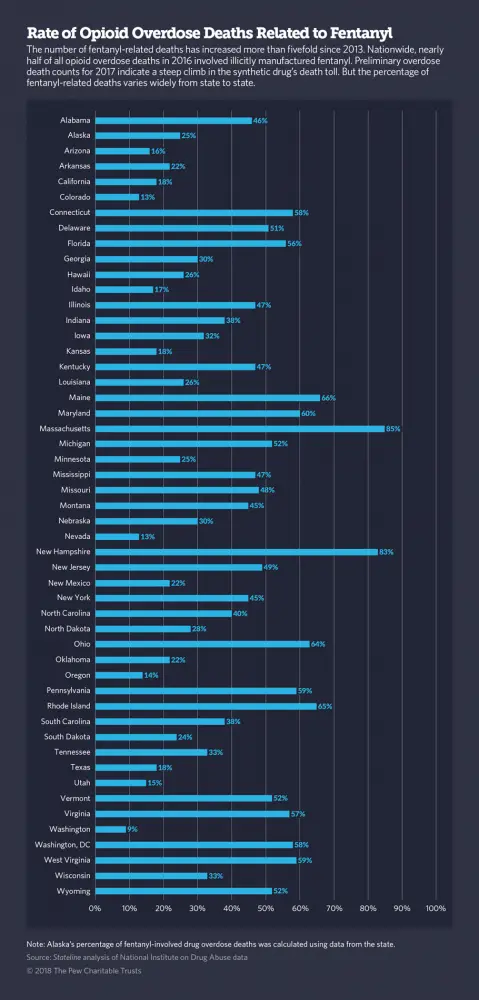
More than a decade into the opioid epidemic, illicit fentanyl and related synthetic drugs are now driving the nation’s spiraling overdose death toll. Involved in nearly half of the roughly 200 U.S. drug overdose deaths every day, fentanyl appears to be here to stay.
“Even if we do a really good job at the border and start making a serious dent in shipments from China and Mexico, we need to anticipate that people will simply start cooking it here. It’s already happening,” U.S. Customs and Border Protection operations manager Stephen McConachie said in an interview.
As governors in the hardest-hit New England, Mid-Atlantic and Midwestern states call for intensified law enforcement efforts and stiffer penalties for fentanyl dealers, public health officials are saying this latest drug scourge underscores the urgent need to get more people into treatment, particularly those who use heroin.
With lethal amounts of fentanyl showing up in heroin and other drug supplies throughout the country, active drug users are at a greater risk of dying than ever before, said Jay Butler, director of public health at the Alaska health department and past president of the Association of State and Territorial Health Officials.
Even as the number of new heroin users declined last year, according to a recent survey by the federal Substance Abuse and Mental Health Services Administration, the number of current drug users exposed to fentanyl appears to be growing, Butler said.
ne hundred times more potent than morphine, the synthetic drug fentanyl has been contaminating illicit drug markets for decades. A 1988 New York Times article reported a spate of overdose deaths in western Pennsylvania from “China White, a powerful synthetic heroin” that the article said had “plagued California in the early 1980’s.”
But, according to the Centers for Disease Control and Prevention, fentanyl’s popularity didn’t take off until 2013, propelling what the agency now calls the third wave of the opioid epidemic, after painkillers and heroin.
Fentanyl is cheap and easy to manufacture and smuggle, and it was involved in almost half of the more than 72,000 U.S. drug overdoses in 2017, according to the Centers for Disease Control and Prevention. The latest numbers show a sharp increase over 2012, when fentanyl was involved in only 6 percent of the more than 41,000 U.S. drug overdoses.
Detecting Shipments
Fentanyl can be purchased online and shipped directly to a user’s home, prompting some to call it the Amazon of illicit drugs. Many dealers, primarily in Mexico, routinely ship via the U.S. Postal Service, FedEx and other private carriers.
Unlike pharmaceutical-grade fentanyl, which is used in hospitals for severe pain and anesthesia, the precise chemical formula for illicitly made fentanyl has been shifting, making it increasingly difficult to detect in autopsies, hospitals, drug treatment centers and crime labs.
At international mail terminals in New York, Chicago, Los Angeles, San Francisco and a handful of other locations, customs officials scan millions of parcels using X-ray devices to identify those that might contain fentanyl and other illicit drugs. And the force began last year to deploy dogs trained to sniff packages and alert agents when they detect fentanyl.
Even when agents find an envelope or parcel containing a white powder they think is fentanyl, it can take days to confirm because dealers continuously change the chemical formulas to elude law enforcement, according to Customs and Border Control.

But even with beefed-up federal resources and new shipping rules, tamping down international shipments of fentanyl will be an uphill battle, McConachie said.
And because the fine white crystals are so potent, drug dealers can add undetectable amounts of fentanyl to heroin, cocaine and counterfeit pills to create more desirable products with higher highs and steeper price tags.
The problem is, the synthetic drug is so potent that a slip of the hand or a dusty blender can result in a bad batch that can kill multiple users almost instantly.
Regional Outbreaks
One of the earliest reported instances of mass fentanyl overdoses in the current opioid epidemic occurred in Huntington, West Virginia, in 2016, when 26 people overdosed in four hours. Similar outbreaks have become commonplace in New England, the Midwest and the Mid-Atlantic, according to newspaper reports.
At the University of Maryland Medical Center in Baltimore, emergency room physician Zachary Dezman said that rashes of multiple overdose cases are more common than individual overdoses these days, because a single batch of heroin with too much fentanyl typically affects multiple users.
“We’ll see waves of folks coming in and when we talk to EMS, they tell us the people came from the same two-block area where several others were found dead.”
Many overdose victims that come into the ER, Dezman said, have been using heroin every day for years or even decades with few problems. They typically say they didn’t know the heroin they were using was laced with fentanyl, he said.
“Unlike overdose deaths from prescription painkillers and heroin, which occur one at a time, we’re seeing fentanyl-involved overdoses in outbreaks,” Butler said. That presents unique challenges for first responders and public health officials nationwide, he said.
Most states have stepped up to the challenge by stockpiling the opioid overdose rescue drug Narcan, or naloxone, and sharing law enforcement information on drug seizures and medical examiner autopsy reports that detect fentanyl. And in a few cities, test strips used to detect the presence of fentanyl in heroin are distributed to drug users.
Still, fentanyl and related synthetic drugs are killing more people than any other illicit drug, and the lethal substance is showing up in far-flung parts of country, as well as intensifying in states already inundated by it.
New Hampshire, Massachusetts, West Virginia and Ohio have the highest death rates from fentanyl, according to the CDC. In Massachusetts, where deaths from heroin and prescription opioids have declined, fentanyl-related deaths accounted for more than 85 percent of all opioid overdose deaths in 2016, according to CDC data.
Most recently, the CDC reported a tripling of fentanyl-involved deaths in the District of Columbia, Illinois and Maryland, and a more than doubling in Connecticut, Missouri, New York, Virginia, Vermont and Wisconsin.
Meanwhile, the estimated supply of fentanyl entering the United States, based on drug seizures and toxicology reports, has shot up exponentially in the past five years, according to congressional testimony from Drug Enforcement Administration deputy operations chief Paul Knierim.
Customs and Border Protection chemist Michael McCormick explained in an interview that synthesizing fentanyl is basic chemistry, no more difficult than cooking methamphetamines. But so far, domestic synthesis labs appear to be rare, he said. “Why would you make it when it’s so cheap to buy?”
User Preferences
By all accounts, a small minority of drug users seek out illicit fentanyl, mainly those who inadvertently used it before and, as a result, find it harder to get high on less-potent heroin.
Although the CDC reports some overdose deaths from fentanyl mixed with cocaine and counterfeit pills made to look like Xanax, OxyContin and other prescription drugs, the vast majority of deaths are the result of fentanyl mixed with heroin or combined with an inert white powder and sold as heroin.
For that reason, current and future heroin users are at the greatest risk of fentanyl-related overdose death, said Andrew Kolodny, who directs opioid research at Brandeis University’s Heller School for Social Policy and Management.
While fentanyl-laced heroin and other drugs appear to be spreading rapidly, affecting every state, fentanyl is killing people episodically only in certain cities, counties and neighborhoods where dealers inadvertently are selling heroin and other drugs combined with lethal quantities of the substance, Kolodny said.
States and cities that already have a large number of heroin users can expect to be hit hardest in the future, he said.
According to research conducted by the University of California at San Francisco Department of Family and Community Medicine, drug users describe fentanyl as having a more intense rush compared with heroin but of a shorter duration. When mixed with heroin, however, some fans of fentanyl said it offered the “best of both worlds,” with the intense initial rush of fentanyl and the lingering high of heroin, the researchers found.
Killing Customers
Still, most users say they try to avoid fentanyl, according to surveys conducted by Brown University researchers. And a recent DEA report based on interviews with drug distributors indicates that most of their customers are fearful of fentanyl.
A dealer in Phoenix, for example, said that his clients were afraid of counterfeit OxyContin pills that contained fentanyl, because they said the pills “have poison in them.”
And distributors in Ohio, Pennsylvania, Delaware and South Carolina indicated it was hard to tell whether the heroin they were selling contained fentanyl, much less how much.
In general, distributors said they attempted to reassure users by pointing out color differences between heroin and fentanyl-laced heroin, but admitted they were uncertain about their product’s contents, according to the report.
“There’s no evidence that the bad guys want to kill their customers,” said McConachie, with Customs and Border Protection.
For now, drug distributors are still experimenting with how to make fentanyl and other synthetic drugs, and unsophisticated local dealers are often sloppy when mixing fentanyl with other substances.
That’s expected to change as the business of fentanyl trafficking matures. But even if drug traffickers become more sophisticated and stop killing so many of their customers, McConachie said, that won’t necessarily decrease the overall number of U.S. overdose fatalities, since the number of users of fentanyl is expected to grow, not shrink.
In Baltimore, Dezman said, local drug users report that some dealers give free heroin to customers who sign up to serve as human guinea pigs by testing new batches of fentanyl-laced products.
“If they don’t die,” he said, “they know the batch is OK.”
–Christine Vestal, Stateline





























Savannah's Crusade says
We lost our precious daughter last October due to this. What our family has been through is unimaginable. Please share the information in the above article as much as possible to help prevent families and their loved ones from suffering.
Dave says
If only it were regulated and we had centers for people to use clean heroin instead of dying on this synthetic crap. People use drugs, whether its beer and wine, cigars or cigarettes, heroin or cocaine, we all have different needs and everyone deserves to have safe access.
Really says
Roulette
Agkistrodon says
Best prevention, DON’T DO IT. You will NOT win the battle. Not worth the time it takes from you. Nothing new here.
B says
We need treatment centers to give drug addicted people clean drugs to use the drug person will find drugs were ever they can let them show up and get there drugs from a clean safe place it will stop death stop crimes again a druggies will always find drugs
August Max. says
This past year (I believe) there was a dealer IN FLAGLER County, who was selling Fentanyl in his Heroin. He is no w in Prison. A young woman I know ODed, from the laced drugs, and was unconscious for two days, her also wasted housemates– stupidly , left her there- leaving her to die. She is in recovery now, gratefully.
gmath55 says
1 million doses of fentanyl found in suitcase at Nashville airport.
http://www.columbiadailyherald.com/news/20181019/1-million-doses-of-fentanyl-found-in-suitcase-at-nashville-airport